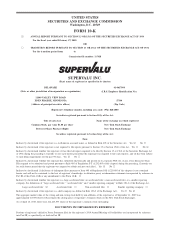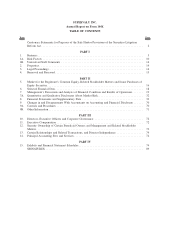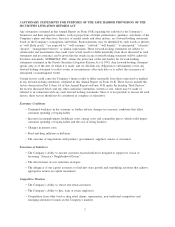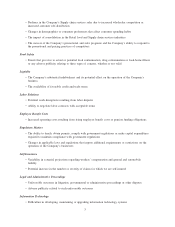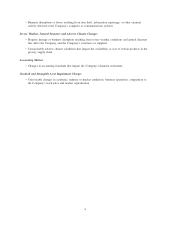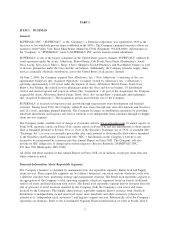Albertsons 2010 Annual Report Download - page 16
Download and view the complete annual report
Please find page 16 of the 2010 Albertsons annual report below. You can navigate through the pages in the report by either clicking on the pages listed below, or by using the keyword search tool below to find specific information within the annual report.The term of office of each executive officer is from one annual meeting of the Board of Directors until the
next annual meeting of Board of Directors or until a successor is elected. There are no arrangements or
understandings between any executive officer of the Company and any other person pursuant to which any
executive officer was selected as an officer of the Company. There are no family relationships between or
among any of the executive officers of the Company.
Each of the executive officers of the Company has been in the employ of the Company or its subsidiaries for
more than five consecutive years, except for Craig C. Herkert, Julie Dexter Berg, Steven J. Jungmann, Peter J.
Van Helden and Daniel J. Zvonek.
ITEM 1A. RISK FACTORS
Various risks and uncertainties may affect the Company’s business. Any of the risks described below or
elsewhere in this Annual Report on Form 10-K or the Company’s other SEC filings may have a material
impact on the Company’s business, financial condition or results of operations.
Current economic conditions
Weakness in the economy and reduced consumer confidence contributed to the decline in consumer spending
and to consumers trading down to a less expensive mix of products or to consumers trading down to
discounters for grocery items. In addition, in fiscal 2010, the Company experienced low levels of inflation. In
this uncertain economy, it is difficult to forecast whether fiscal 2011 will be a period of inflation or deflation.
Food deflation could reduce sales growth and earnings, while food inflation, combined with reduced consumer
spending, could reduce gross profit margins. If these consumer spending patterns continue or worsen, along
with an ongoing soft economy, the Company’s financial condition and results of operations may be adversely
affected.
Execution of initiatives
The Company is positioned in the retail food industry as the only traditional food retailer with multiple
formats and ownership models that can be used to address differing customer needs across the United States.
Management believes that this diversity of go-to-market options differentiates the Company and is part of its
vision of becoming “America’s Neighborhood Grocer.” The Company has launched certain initiatives to
achieve this vision and enhance performance through a greater focus on the customer and simplification of the
in-store shopping experience combined with reducing its overall cost structure and further leveraging its size.
The Company plans to significantly increase the number of hard-discount stores and to reinvest in its existing
store base through remodels and merchandising initiatives tailored to the unique needs of each particular
store’s neighborhood. If the Company is unable to execute on these initiatives, the Company’s financial
condition and results of operations may be adversely affected.
High level of competition in the Retail food and Supply chain services businesses
The Company’s Retail food business faces competition for customers, employees, store sites, products and in
other important areas from traditional grocery retailers, including regional and national chains and independent
food store operators, and non-traditional retailers, such as supercenters, membership warehouse clubs, specialty
supermarkets, drug stores, discount stores, dollar stores, convenience stores and restaurants. The Company’s
ability to attract customers in this business is dependent, in large part, upon a combination of price, quality,
assortment, brand recognition, store location, in-store marketing and merchandising, promotional strategies and
continued growth into new markets. In addition, the nature and extent to which our competitors implement
various pricing and promotional activities in response to increasing competition and the Company’s response
to these competitive actions, can adversely affect profitability.
The Company’s Supply chain services business is primarily wholesale distribution and includes a third-party
logistics component. The distribution component of the Company’s Supply chain services business competes
10


